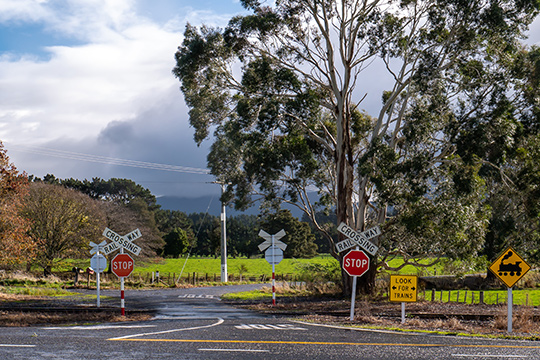Urban KiwiRAP: Risk Assessment Process
Two primary risk assessment processes form the basis of Urban KiwiRAP; one for intersections and another for corridors.
Intersection Risk Assessment Process

The Urban KiwiRAP intersection risk assessment process directly adopts the process described in the New Zealand Transport Agency’s High-Risk Intersections Guide (July 2013).
The ‘High-Risk Intersections Guide’ provides practitioners with best practice guidance to identify, target and address key road safety issues at high-risk intersections. The approach aligns with Safer Journeys focus on reducing deaths and serious injuries.
The High-Risk Intersections Guide introduces a new technique for identifying intersections that have a disproportionally higher than average risk of future deaths or serious injuries if recent crash trends continue. The new technique calculates an estimated number of Death and Serious injury (DSi) casualty equivalents based on relationships between speed environment, intersection form and control type and crash movement type factors. This approach is founded on knowledge that crash outcomes vary as a function of speed, intersection form and control type, and crash movement type. The DSi casualty equivalents method acknowledges that actual fatal and serious crash data alone is not a good indicator of the underlying risk of a high-severity crash at many intersections.
The High-Risk Intersections Guide provides DSi factors, referred to as ‘Severity Indices’, for all primary crash movement types for the following intersection types:
- Signalised crossroads
- Signalised T-intersections
- Roundabouts
- Priority (Give Way or Stop) controlled crossroads
- Priority (Give Way or Stop) controlled T-intersections
Different severity indices are provided for urban (≤70km/h) and rural (≥80km/h) speed environments. The severity indices in the High-Risk Intersections Guide are calculated based on nationwide crash statistics from 2008 to 2012 and represent the average number of deaths and serious injuries per reported injury crash for each primary crash movement type at a specific intersection form, control type and speed environment.
Risk Metrics
The High-Risk Intersections Guide defines two main types of risk metric: Collective Risk and Personal Risk.
- Collective Risk is measured as the total number of fatal and serious crashes or estimated deaths and serious injuries within 50 metres of an intersection in a crash period.
- Personal Risk is the risk of death or serious injuries per 100 million vehicle kilometres travelled within 50 metres of an intersection.
Collective Risk is calculated by multiplying each reported injury crash at an intersection over the past five years by the corresponding severity index and summing the values. The Collective Risk of an intersection is then categorised into a five-tiered risk threshold classification, from low to high. The thresholds have been determined by analysing the safety performance of thousands of intersections in New Zealand, and set so that intersections with a ‘High’ or ‘Medium-High’ Collective Risk profile (i.e. high-risk) make up fewer than 5% of all intersections in New Zealand.
Collective Risk is the primary risk metric used for prioritising intersections for road safety countermeasures, as high-risk sites are locations that have the greatest potential for reduction in road trauma.
By contrast, Personal Risk measures the risk to each person using the intersection. In practice only the number of motor vehicles travelling through an intersection is routinely available, so Personal Risk is calculated from the Collective Risk divided by a measure of traffic volume exposure. Intersections with the highest risk per vehicle are ranked as highest risk from a Personal Risk perspective. Personal Risk is the most relevant risk metric for communicating road safety issues with the public, as risk is defined at an individual level.
Personal Risk is calculated for all intersections that have four or more injury crashes in a crash period. The threshold is required because it is essential to have sufficient numbers of crashes to establish an appropriate safety countermeasure.
Corridor Risk Assessment Process

A key innovation in this project has been the development of a risk assessment process for urban corridors.
One of the first tasks for the Urban KiwiRAP Technical Committee was to decide whether corridor risk would be assessed using a fatal and serous crash based approach, such as that adopted for the original KiwiRAP work on the rural State Highway network, or an estimated DSi casualty equivalents approach as incorporated in the High-Risk Intersection Guide. Given fatal and serious crashes tend to be relatively rare and random events in urban environments, and the shifting focus from crashes to casualties expressed in Safer Journeys, the decision was made to adopt the estimated DSi casualty equivalents approach.
Corridor Definition
The first step in the process is to develop a standard method for defining a corridor that can be applied across any road controlling authority’s transport network.
Before any corridor risk metrics could be developed, a standard method for defining an urban corridor needed to be developed; one which could be applied to any Road Controlling Authority’s transport network. The critical factor in developing such a methodology is to base the influencing variables on information that is common to and/or applicable to any region.
Defining a corridor based on the hierarchical classification of the road and intersecting roads was the preferred approach. This approach was favoured as it generally resulted in a logical segmentation of roads into corridors where there were distinct changes in the physical nature and/or operation (traffic volume) of the road.
The process used to define a corridor as a contiguous group of roads as corridor were:
- A change in road hierarchy along the road;
- A change in speed environment from urban to rural (and vice versa);
- A change in road name; and
- At intersections with a side road with the same or higher order hierarchy.
Risk Metrics
As with intersections, severity indices were developed for primary crash movement types for mid-block road sections with different lane and speed environments. The severity indices were calculated by extracting all mid-block crashes from the New Zealand Transport Agency Crash Analysis System (CAS) between 2008 and 2012 and determining the average number of DSi casualties for each injury crash in each category.
Corridor risk was calculated in two parts; an intersection component and a mid-block component. Because crashes at intersections typically involve the collision between two vehicles travelling on different, often adjacent legs of an intersection, a means of apportioning an intersection crash to the corridor had to be agreed.
Intersection Component
For corridors, the intersection risk metric component only relates to crashes that occur within a 10m radius of the centre of an intersection.
The process of allocating the intersection risk metric component to a corridor is a function of the hierarchy and the number of legs at the intersection on the following basis:
- If all approaches to the intersection are on a Local Road corridor, then the entire Intersection Collective Risk is assigned to the Local Road corridor.
- Where the intersection includes roads other than Local Roads, the Intersection Collective Risk is apportioned between the non-Local Road corridors.
The intersection risk metric component for corridors is calculated using the severity indices specified in the High Risk Intersections Guide.
Mid-Block Component
For corridors, the mid-block component relates to all parts that do not meet the intersection component definition. All injury crashes along mid-block sections are multiplied by the corresponding severity index based on the crash movement type, the lane configuration and speed environment. The mid-block component of the corridor risk is calculated by summing the DSi casualty equivalents of all mid-block sections along the corridor.
The Collective Risk of a corridor is calculated by adding together the intersection and mid-block DSi casualty equivalents and dividing by the total corridor length in kilometres. Dividing by corridor length enables direct comparisons to be made between corridors of different lengths.
As with intersections, Personal Risk for a corridor measures the risk to each person travelling along the corridor.
Active Road User Risk Assessment Process

With a growing desire to understand the risk that is posed to Active Road Users (ARU) within transport networks, separate intersection and corridor risk analyses has been completed for crashes involving ARU. This includes crashes that involve bicycles, skateboards, inline skaters, pedestrians, wheelchairs, power chairs or mobility scooters.
As volumes of ARU across many parts of the transport network is unknown, only Collective Risk values are calculated.
The ARU intersection Collective Risk categories utilise the values for all road users, but shift the thresholds by one rating band. For example, the ARU intersection Collective Risk threshold of Medium High risk is equivalent to Medium Risk for all road users. There is no ‘Actual High’ threshold for ARU.
Similarly for corridors, the ARU thresholds utilise the values for all road users but are one rating band different to those that apply for all road users.
Motorcycle Assessment Process
The increasing numbers of motorcycles and the severity of trauma that occurs for them in a crash has created a desire to understand the risk that is posed to Motorcyclists within transport networks.
More Information
A Technical Guide with in-depth information on the calculations and engineering detail of the methodology used will be available in the future.
For more information about KiwiRAP and iRAP programmes please refer to the KiwiRAP website at www.kiwirap.org.nz.

